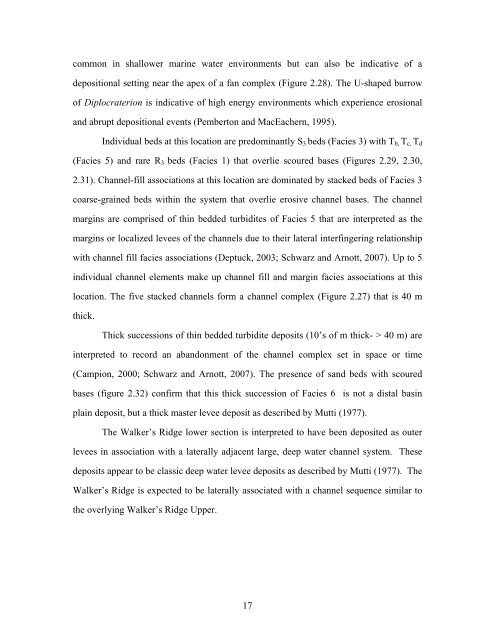Copyright by Nysha Chaderton 2009 - The University of Texas at ...
Copyright by Nysha Chaderton 2009 - The University of Texas at ...
Copyright by Nysha Chaderton 2009 - The University of Texas at ...
Create successful ePaper yourself
Turn your PDF publications into a flip-book with our unique Google optimized e-Paper software.
common in shallower marine w<strong>at</strong>er environments but can also be indic<strong>at</strong>ive <strong>of</strong> a<br />
depositional setting near the apex <strong>of</strong> a fan complex (Figure 2.28). <strong>The</strong> U-shaped burrow<br />
<strong>of</strong> Diplocr<strong>at</strong>erion is indic<strong>at</strong>ive <strong>of</strong> high energy environments which experience erosional<br />
and abrupt depositional events (Pemberton and MacEachern, 1995).<br />
Individual beds <strong>at</strong> this loc<strong>at</strong>ion are predominantly S3 beds (Facies 3) with Tb, Tc, Td<br />
(Facies 5) and rare R3 beds (Facies 1) th<strong>at</strong> overlie scoured bases (Figures 2.29, 2.30,<br />
2.31). Channel-fill associ<strong>at</strong>ions <strong>at</strong> this loc<strong>at</strong>ion are domin<strong>at</strong>ed <strong>by</strong> stacked beds <strong>of</strong> Facies 3<br />
coarse-grained beds within the system th<strong>at</strong> overlie erosive channel bases. <strong>The</strong> channel<br />
margins are comprised <strong>of</strong> thin bedded turbidites <strong>of</strong> Facies 5 th<strong>at</strong> are interpreted as the<br />
margins or localized levees <strong>of</strong> the channels due to their l<strong>at</strong>eral interfingering rel<strong>at</strong>ionship<br />
with channel fill facies associ<strong>at</strong>ions (Deptuck, 2003; Schwarz and Arnott, 2007). Up to 5<br />
individual channel elements make up channel fill and margin facies associ<strong>at</strong>ions <strong>at</strong> this<br />
loc<strong>at</strong>ion. <strong>The</strong> five stacked channels form a channel complex (Figure 2.27) th<strong>at</strong> is 40 m<br />
thick.<br />
Thick successions <strong>of</strong> thin bedded turbidite deposits (10’s <strong>of</strong> m thick- > 40 m) are<br />
interpreted to record an abandonment <strong>of</strong> the channel complex set in space or time<br />
(Campion, 2000; Schwarz and Arnott, 2007). <strong>The</strong> presence <strong>of</strong> sand beds with scoured<br />
bases (figure 2.32) confirm th<strong>at</strong> this thick succession <strong>of</strong> Facies 6 is not a distal basin<br />
plain deposit, but a thick master levee deposit as described <strong>by</strong> Mutti (1977).<br />
<strong>The</strong> Walker’s Ridge lower section is interpreted to have been deposited as outer<br />
levees in associ<strong>at</strong>ion with a l<strong>at</strong>erally adjacent large, deep w<strong>at</strong>er channel system. <strong>The</strong>se<br />
deposits appear to be classic deep w<strong>at</strong>er levee deposits as described <strong>by</strong> Mutti (1977). <strong>The</strong><br />
Walker’s Ridge is expected to be l<strong>at</strong>erally associ<strong>at</strong>ed with a channel sequence similar to<br />
the overlying Walker’s Ridge Upper.<br />
17
















